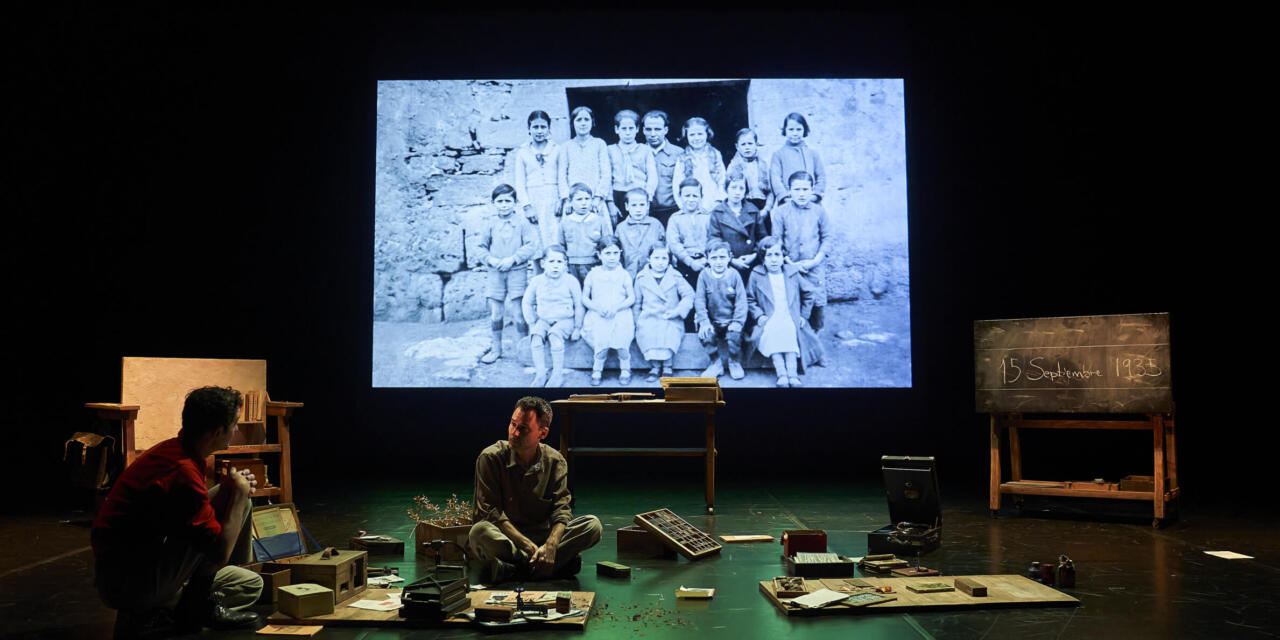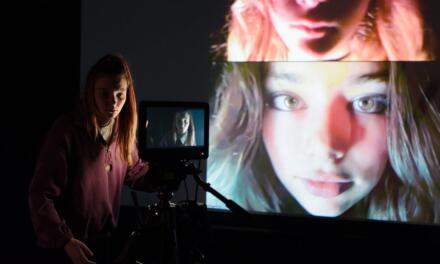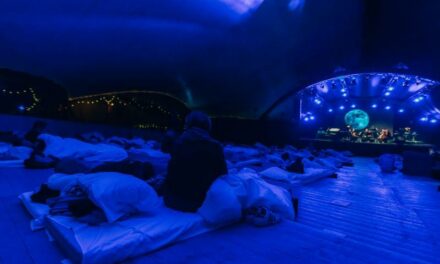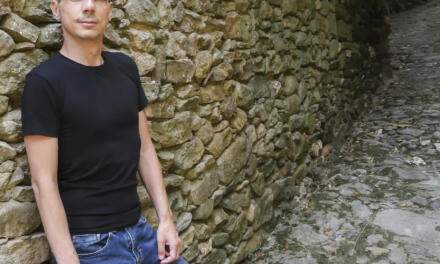Xavier Bobés is one of those remarkable artists able to conjure a world through a few objects that he animates with a magician’s sense of the unexpected. His dramaturgy provides the spectator with a window into the past, to things that have been sidelined or forgotten. In Cosas que se olvidan fácilmente/Things Easily Forgotten, Bobés conjured the history of Spain in the dictatorship years through a series of objects, magazines, photographs and postcards found in a flea market. It was a remarkable piece of theatre that encouraged those of us who witnessed Bobés dexterous object manipulation to consider the traces that history leaves behind and how we construct histories from these everyday objects so often seen as unimportant or insignificant.
Bobés’s newest piece, El mar. Visión de unos niños que no lo han visto nunca/The Sea. Vision of some children who have never seen it, is epic in comparison to his previous work. There were five of us experiencing Things Easily Forgotten when I saw it at Birmingham’s BE Festival in 2015, over 200 were in the audience on the February night when I saw El mar at the Sala José Luis Alonso, part of Madrid’s Teatro de la Abadía.
Premiering at the Teatre Nacional de Catalonia in February 2022 and touring across Spain since then, El mar is co-authored and co-directed with dramatist Alberto Conejero, author of La Piedra oscura/The Dark Stone (2014), El dia de la nieve/The Day of Snow (2018), and the revised version of Lorca’s Comedía sin título/Play without a Title (2019) among other works. El mar melds Conejero’s interests in historical memory and storytelling and Bobés’s magical ability to transport an audience into a different era through shadow play, projection and the animation of objects that acquire a new agency in performance.
El mar centres on the story of Antoni Benaiges, a Catalan teacher from Mont-roig del Camp (in the province of Tarragona) with a veritable vocation rooted in French educationalist Célestin Freinet’s ideas of pedagogy based on cooperative and enquiry-based learning. With a vision aligned to the values of Spain’s Second Republic which sought between 1931 and 1936 – the year Franco’s Rebel Forces launched the Civil War – to increase literacy across the nation, Benaiges sought to make a difference. Working from Benaiges’ correspondence and writings, the documentary materials that the photographer Sergi Bernal has assembled on the teacher and his legacy in his book Desenterrant el silence/Digging Up the Silence, the testimony of the children Benaiges taught and the writings of philosopher Marina Garcés from her 2020 book Escuela de aprendices/School of Apprentices, Conejero has crafted a dramaturgy that not only articulates Benaiges’ achievements but rather provides a series of reflections on why education matters and how it helps a society understand its responsibilities.
Posted in 1934 to a small school in Bañuelos de Bureba, a village with just 200 inhabitants in the area of Burgos, Benaiges animates his young pupils by buying for the classroom a printing press where the students can publish their work and a gramophone where they can learn about music. Sergi Torrecilla plays Benaiges — a cheerful optimistic persona in a red shirt (a marker of his political ideology) and beige trousers — who always celebrates what is possible. Torrecilla narrates in the first-person capturing Benaiges’ energy and commitment, but also steps out of character to take on the roles of the classroom children and Benaiges’ mother at different points in the production. Bobés lingers in the shadows, conjuring images projected on a screen at the back of the stage — as with a village that is created from a tiny box — and throwing props to Torrecilla, like a battered briefcase that signals his move from Catalonia to Bañuelos de Bureba. Photographs of Benaiges and his class from his years in Bañuelos de Bureba are projected on the screen above — images frozen in time but also brought strikingly into the present as testimony of those children taught by Benaiges, now elders in their 80s and 90s, recall the impact he had on their lives and the threat he posted to parents suspicious of learning. The production openly acknowledges the different layers of text and image that Conejero and Bobés have drawn on in crafting the work. History comes to life in El mar.
Pep Aymerich’s set is simple but effective. A series of tables on wheels that are deftly moved by Bobés and Torrecilla into a series of configurations. Gliding across the stage, the tables create a classroom that is lithe, agile and interactive. A blackboard is fashioned from a table that that opens out. Bobés writes dates on the blackboard to orientate the audience as to the passing of time. A pasodoble sees Torrecilla and Bobés dance across the stage articulating the power of music embodied by the gramophone. Bobés uses a small camera tucked into a wooden box to reveal the magical contents of trunks, desks, magazines and letters which are subsequently projected on the screen — at times fusing into animations that serve to underline the relationship between the fictional and documentary that El mar nimbly navigates. Books and the magazines the children create with Benaiges – Gestos for the older children, Recreo for the younger ones — evoke a world of possibilities and imagination beyond the confines of the highly conservative village.
Letters are adroitly set in the printing press by Bobés, captured by his camera and projected on the screen so the audience misses none of the detail. The lighting by Jou Serra and Mario Andrés Gómez helps animate the objects, bathing them in a mystery that comes into its own through the magnified projections. The spelling errors in the children’s short essays are part of an understanding of education that recognises mistakes and errors as key components in a process of learning, part of an understanding of what it means to be human. Albert Coma’s projection design is like Aymerich’s set unassuming, clean and sinewy, evoking the digital blackboard that is such a feature of contemporary education. Julià Carboneras’ sound deslgn is similarly evocative – the sense of a rural village suggested through the cocks crowing and birds chirping, the classroom’s energy sensed in the background noise. At the play’s end the sound of digging points to the exhumation of Benaiges’ remains from a mass grave holding over 300 bodies, close to Bañuelos de Bureba, in 2010.
The play’s title refers to a sea that the children have never seen. In January 1936, Benaiges’ class created a book of poems and reflections where they deliberated on what they imagined the sea to be. His plans to take them to the sea that summer were interrupted by the coup d’état that plunged Spain into civil war. Torrecilla’s Benaiges addresses the audience as if we are the children producing the poems on a sea we have never seen but only conjured in our imaginations. The different writings on the sea that the class produce are read out by Torrecilla in their entirety – the actor delicately shifting his voice to pick up the different registers, tones and characters of each of the school children.
Benaiges was assassinated on 25 July 1936, in the early weeks of the Civil War. His murder, preceded by torture, is announced by a chair knocked over by Torrecilla. Torrecilla narrates dispassionately the treatment Benaiges received when arrested for being a teacher. Burgos, one of the most conservative regions of Spain, fell quickly to the Rebel Forces in the Civil War, becoming the seat of Franco’s nationalist government. Hostility to Benaiges’ ideas is present in the comments he receives from parents who don’t appreciate his emancipated approach to education. A crucifix removed from the wall of a classroom by Bobés as the Second Republic is forged is deftly replaced by Bobés when the Civil War begins. The threat of the right is never far from the piece’s surface. The crucifix symbolises a Spain that sees no separation between Church and State and where a particular understanding of Catholicism drives a limited understanding of education. In El mar, Torrecilla narrates how a child defies their mother to travel to school in the snow. The sense of questioning that he inspires in the children – evidenced in the written pieces read out during the production – demonstrate why teachers were so feared by the Franco regime. They encouraged children to question, to interrogate, to imagine other possibilities. At the piece’s end, Benaiges may be physically absent but he is evoked through the words of those he taught, who read from the magazines he helped them create.
The selection of Marina Garcés writings which are used to frame the beginning and end of the piece draw parallels between a stage and a school: the need for an actor and an audience finding an analogy in that of a teacher and their pupils. At the Abadía the audience become the children in a classroom that operates as a space of wondrous possibilities – we are immersed into this world and encouraged to deploy our imaginations: “Dream you say to them and you say to them write and you say to them you will have another future if you are capable of imagining it.”
“What makes us human is that we don’t know how to live” flashes on the screen at the production’s opening. Learning how to live is what Benaiges sought to encourage his children to discover. Learning as a process, never finished, never complete: like democracy, it appears a work in progress that we should never give up on. El mar is one of those pieces that reminds an audience of the implications of the decisions they make. Benaiges — “a summer son,” as his mother refers to him, returning home only in the summer holidays when the school year comes to an end — celebrated the art of the possible. El mar conjures a lost life which is animated through performance. It is a delicate, lyrical and deeply political piece of theatre that positions learning as nothing less than a way of life.
El mar. Visión de unos niños que no lo han visto nunca/The Sea. Vision of some children who have never seen it played at Madrid’s Teatro de la Abadía from 15 to 26 February; it tours to Terrassa Arts Escèniques on 11 March, the Teatro Principal Burgos on 25 March, and the Teatre Joan Colet Calafell on 2 April.
This post was written by the author in their personal capacity.The opinions expressed in this article are the author’s own and do not reflect the view of The Theatre Times, their staff or collaborators.
This post was written by Maria Delgado.
The views expressed here belong to the author and do not necessarily reflect our views and opinions.


















